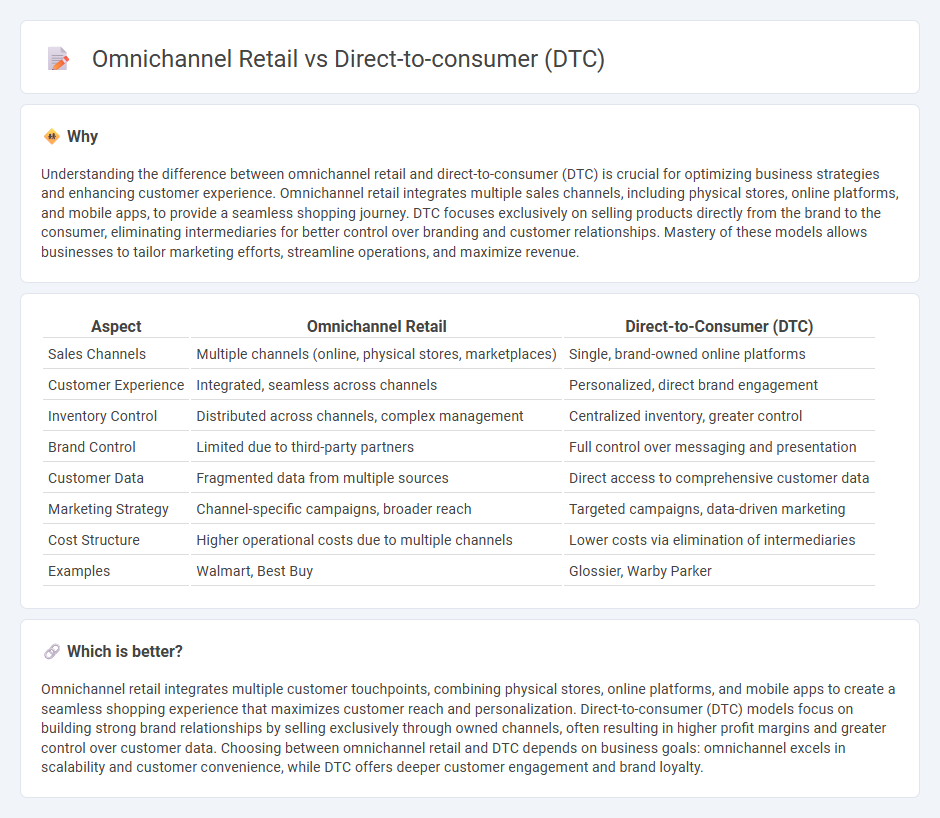
Omnichannel retail integrates multiple platforms like physical stores, e-commerce, and mobile apps to create a seamless shopping experience, enhancing customer reach and engagement. Direct-to-consumer (DTC) brands bypass traditional retailers by selling exclusively through their own channels, allowing for greater control over branding, pricing, and customer data. Explore how these strategies transform commerce dynamics and drive consumer loyalty.
Why it is important
Understanding the difference between omnichannel retail and direct-to-consumer (DTC) is crucial for optimizing business strategies and enhancing customer experience. Omnichannel retail integrates multiple sales channels, including physical stores, online platforms, and mobile apps, to provide a seamless shopping journey. DTC focuses exclusively on selling products directly from the brand to the consumer, eliminating intermediaries for better control over branding and customer relationships. Mastery of these models allows businesses to tailor marketing efforts, streamline operations, and maximize revenue.
Comparison Table
| Aspect | Omnichannel Retail | Direct-to-Consumer (DTC) |
|---|---|---|
| Sales Channels | Multiple channels (online, physical stores, marketplaces) | Single, brand-owned online platforms |
| Customer Experience | Integrated, seamless across channels | Personalized, direct brand engagement |
| Inventory Control | Distributed across channels, complex management | Centralized inventory, greater control |
| Brand Control | Limited due to third-party partners | Full control over messaging and presentation |
| Customer Data | Fragmented data from multiple sources | Direct access to comprehensive customer data |
| Marketing Strategy | Channel-specific campaigns, broader reach | Targeted campaigns, data-driven marketing |
| Cost Structure | Higher operational costs due to multiple channels | Lower costs via elimination of intermediaries |
| Examples | Walmart, Best Buy | Glossier, Warby Parker |
Which is better?
Omnichannel retail integrates multiple customer touchpoints, combining physical stores, online platforms, and mobile apps to create a seamless shopping experience that maximizes customer reach and personalization. Direct-to-consumer (DTC) models focus on building strong brand relationships by selling exclusively through owned channels, often resulting in higher profit margins and greater control over customer data. Choosing between omnichannel retail and DTC depends on business goals: omnichannel excels in scalability and customer convenience, while DTC offers deeper customer engagement and brand loyalty.
Connection
Omnichannel retail and direct-to-consumer (DTC) strategies are interconnected by their focus on seamless customer experiences across multiple touchpoints, including online platforms, physical stores, and social media. Both approaches prioritize data-driven personalization, real-time inventory management, and integrated supply chains to enhance consumer engagement and loyalty. Leveraging omnichannel capabilities allows DTC brands to expand their reach while maintaining direct relationships with customers and improving operational efficiency.
Key Terms
Customer Journey
Direct-to-consumer (DTC) retail offers a streamlined customer journey by providing a direct connection between brands and consumers, enhancing personalization and reducing intermediaries. Omnichannel retail integrates multiple touchpoints including physical stores, online platforms, and mobile apps, creating a seamless and cohesive customer experience across channels. Explore how these strategies impact customer engagement and conversion by diving deeper into their distinct approaches.
Channel Integration
Direct-to-consumer (DTC) retail relies on a singular channel, typically the brand's own website or physical stores, enabling focused marketing and direct customer relationships but limiting reach. Omnichannel retail integrates multiple channels, including online platforms, brick-and-mortar stores, social media, and mobile apps, providing a seamless and consistent shopping experience across all touchpoints. Explore how strategic channel integration optimizes customer engagement and drives revenue growth in evolving retail landscapes.
Data Ownership
Direct-to-consumer (DTC) retail maximizes data ownership by collecting first-party customer insights directly through proprietary channels, enabling personalized marketing and product development. Omnichannel retail integrates multiple sales platforms, but often relies on third-party data and partners, complicating data consolidation and ownership rights. Explore deeper strategies and benefits of data ownership in DTC versus omnichannel retail.
Source and External Links
Direct to Consumer (DTC) Sales: Tips and Examples to Sell More - Direct-to-consumer (DTC) is a sales model where brands sell their products directly to customers without intermediaries, allowing for greater control over branding, better customer data insights, and higher profit margins.
Direct-to-consumer - Wikipedia - DTC is a business model of selling products directly to customers, usually via e-commerce, bypassing retailers and wholesalers, which gained popularity during the late 1990s and has grown significantly since.
The Ultimate Guide to Direct To Consumer (DTC) - Brightpearl - DTC is a modern sales strategy allowing manufacturers to sell directly to consumers without traditional distributors, enabled by e-commerce platforms, reshaping retail and marketing sectors.
 dowidth.com
dowidth.com